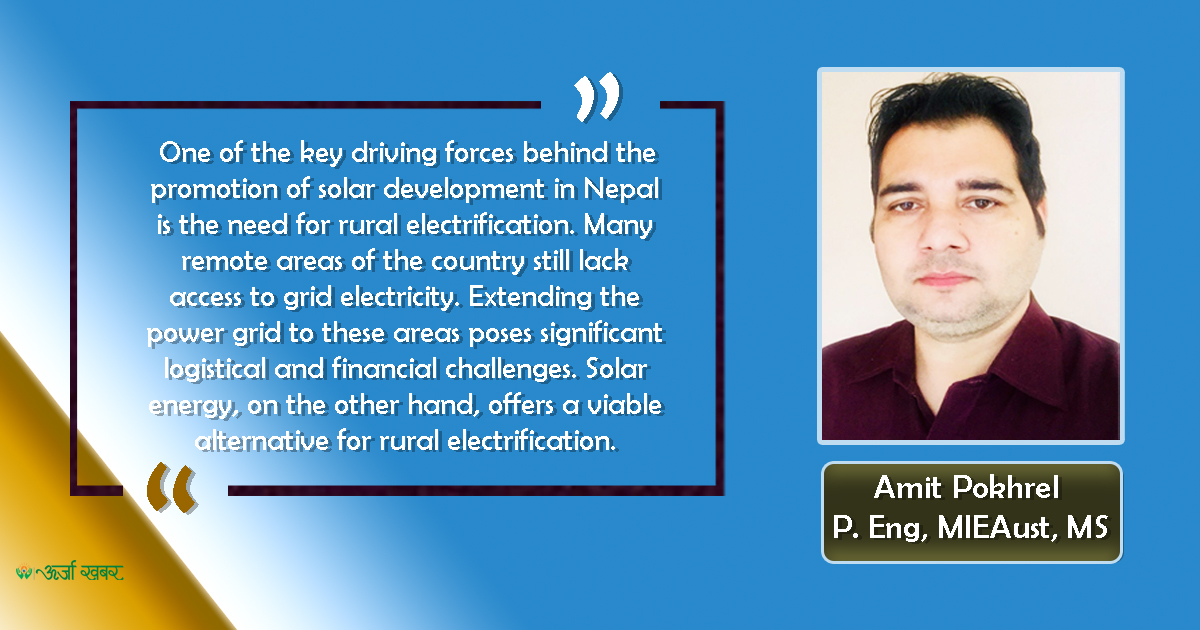Energy Update
Driving Forces to Promote Solar Development in Nepal

Solar energy has gained significant attention worldwide as a clean and renewable source of power. Nepal, a country nestled in the Himalayas, has immense potential for solar energy due to its geographic location. The promotion of solar development in Nepal is driven by several factors that are transforming the country's energy landscape. This article will explore the driving forces behind the push for solar energy in Nepal.
Nepal, like many other developing countries, is facing a rapid increase in energy demand. The growing population, urbanization, and industrialization have all contributed to a surge in electricity consumption. Unfortunately, the existing conventional energy sources, such as hydropower and fossil fuels, are insufficient to meet the rising demand. This has resulted in regular power shortages, especially in remote areas. The need to bridge the energy gap and ensure access to electricity for all has led to a renewed focus on solar energy.

Nepal boasts abundant solar resources, with an average of around 300 sunny days per year. The country's unique geography and location in the higher latitudes make it ideally suited for solar energy generation. The mountainous terrain, in particular, offers ample opportunities for the installation of solar panels. By harnessing this solar potential, Nepal can reduce its reliance on imported fossil fuels and diversify its energy mix.
The Government of Nepal has recognized the importance of solar energy in achieving its development goals. As a result, it has implemented various initiatives and policies to promote solar development. The Ministry of Energy, Water Resources, and Irrigation has been pivotal in driving the uptake of solar energy. It has launched programs such as the "National Renewable Energy Program" and "Solar Rooftop Program" to encourage the adoption of solar technologies across the country. These initiatives provide subsidies, tax incentives, and support for capacity building to make solar energy more affordable and accessible.

One of the key driving forces behind the promotion of solar development in Nepal is the need for rural electrification. Many remote areas of the country still lack access to grid electricity. Extending the power grid to these areas poses significant logistical and financial challenges. Solar energy, on the other hand, offers a viable alternative for rural electrification. By installing solar panels in these off-grid regions, Nepal can provide clean and reliable electricity to its rural population. This not only improves their quality of life but also spurs socio-economic development.
Nepal, being highly vulnerable to climate change, has witnessed the impacts of global warming firsthand. The melting Himalayan glaciers, erratic rainfall patterns, and increased frequency of natural disasters are all evidence of climate change's toll on the country. To mitigate the effects of climate change and reduce greenhouse gas emissions, Nepal has turned to renewable energy sources like solar power. Solar energy production is clean, emits no greenhouse gases, and helps combat air pollution, a major concern in urban areas.
Investing in solar development offers significant economic benefits for Nepal. By reducing its reliance on imported fossil fuels, the country can save foreign exchange and improve its trade balance. Additionally, solar projects create job opportunities in both rural and urban areas. The installation, operation, and maintenance of solar panels require skilled labor, providing employment opportunities for the local workforce. The growth of the solar industry also stimulates economic growth by attracting private investment and fostering innovation.
Conclusion
The driving forces to promote solar development in Nepal can be attributed to a combination of factors, ranging from rising energy demand, abundant solar resources, and government initiatives to the need for rural electrification, climate change mitigation, and economic benefits. As Nepal strives to ensure energy security, access to electricity for all, and protection of the environment, solar energy emerges as a compelling solution. By leveraging its solar potential, Nepal can chart a sustainable energy future while reaping the benefits of clean and renewable power.
The Author of this article works as a Senior Contract & Commercial Expert in the Energy Business of Golyan Group, Kathmandu, Nepal
Conversation
- Info. Dept. Reg. No. : 254/073/74
- Telephone : +977-1-5321303
- Email : [email protected]














